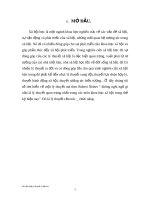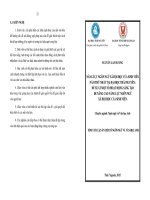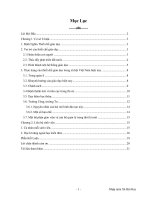TIỂU LUẬN NGÔN NGỮ XÃ HỘI HỌC
Bạn đang xem bản rút gọn của tài liệu. Xem và tải ngay bản đầy đủ của tài liệu tại đây (178.95 KB, 7 trang )
HUE UNIVERSITY
INSTITUTE OF OPEN EDUCATION
AND INFORMATION TECHNOLOGY
ENGLISH LANGUAGE
---🙢🙢🙢---
SOCIOLINGUISTIC PROJECT
Lecturer: PhD. Trần Thuần
Student: Bùi Ngọc Ánh
Student’s code: 7052900486
Class: Nghệ An 6
Topic: Examine the differences between the English spoken in
Boston and the English spoken in the southern area of the
United States. Why do you think there are such dialectal
evidence
Nghệ An - 2023
1
I. Introduction
English, as the official and widely spoken language in the United States,
exhibits rich linguistic diversity across different regions. Two prominent dialects,
Boston English and Southern American English, showcase distinct linguistic
features shaped by historical, cultural, and social influences. This essay aims to
provide a comprehensive analysis of the differences between Boston English and
Southern American English, examining the specific linguistic evidence supporting
these dialectal variations .
1
II. Pronunciation
2
A. Boston English
1. Non-rhoticity: A notable feature of Boston English is its non-rhotic
pronunciation, where the "r" sound is often dropped at the end of words or
before consonants. This linguistic trait can be traced back to the region's
historical connection to British English, particularly the non-rhotic variety
spoken in southeastern England during the colonial era. The pronunciation
patterns of early English settlers, combined with subsequent waves of Irish
immigration in the 19th century, further solidified the non-rhotic nature of
Boston English.
2. Broad "a": Boston English is characterized by the distinct broad "a" sound in
certain words. This phenomenon, known as the "Boston accent," can be
attributed to the region's linguistic heritage influenced by early Puritan
settlers and subsequent waves of Irish immigration. The pronunciation of
words like "park" as "pahk" reflects the historical development of the Boston
accent.
B. Southern American English
1. Rhoticity: In contrast to Boston English, Southern American English is
generally rhotic, meaning the "r" sound is fully pronounced in most
positions. The rhotic pronunciation in Southern dialects can be attributed to
the linguistic influence of English settlers in the Southern colonies, who
spoke rhotic dialects. Unlike the non-rhotic tendencies that emerged in other
regions, the Southern colonies maintained the rhotic pronunciation, which
has persisted over time.
2. Vowel variations: Southern American English exhibits vowel shifts that
differentiate it from other dialects. One notable vowel shift is the
"monophthongization" of the diphthong /aɪ/ to /aː/, resulting in
2
pronunciations like "ride" becoming "rahd." This vowel shift is a
characteristic feature of Southern dialects, influenced by the speech patterns
of early English settlers and subsequent interactions with other languages,
including African languages and various creole languages spoken by
enslaved African Americans. These linguistic interactions gave rise to unique
vowel pronunciations found in Southern American English.
III. Vocabulary
2,3
A. Boston English
1. Terms of Irish influence: Boston English exhibits vocabulary influenced by
the city's significant Irish immigrant population. Irish terms and expressions
have permeated the local dialect, reflecting the cultural and historical ties
between Boston and Ireland. Words like "wicked" used as an intensifier
("very") and phrases like "bang a U-ey" (make a U-turn) exemplify the Irish
influence on Boston English.
2. Distinctive vocabulary: Boston English has developed its own set of unique
vocabulary, often influenced by the region's history, culture, and local
institutions. For instance, terms like "bubbler" for a drinking fountain and
"rotary" for a traffic circle are commonly used in Boston English. These
distinctive vocabulary items contribute to the sense of identity and
community among Bostonians.
B. Southern American English
1. Southern drawl: Southern American English is characterized by a distinct
drawl and slower speech pattern, which sets it apart from other dialects. This
speech pattern reflects the relaxed pace of Southern society and is influenced
by cultural factors such as hospitality and traditions deeply rooted in the
region. The Southern drawl contributes to the overall rhythm and cadence of
Southern American English.
0. Unique vocabulary: Southern American English incorporates vocabulary
specific to the region's cultural heritage and historical context. Expressions
like "y'all" (you all), "fixin' to" (getting ready to), and "bless your heart" (a
phrase with various meanings, including empathy or subtle criticism) are
commonly used in Southern dialects. The unique vocabulary reflects the
region's history of colonial settlement, slavery, and African American
influence, as well as its agrarian roots and distinctive social customs.
IV. Grammar and Syntax
4,5
3
A. Boston English
1. Drop of the auxiliary "to be": In certain contexts, speakers of Boston English
omit the auxiliary "to be" in present tense constructions. This linguistic
feature is known as "contracted be." For example, "She is going" becomes
"She going." This phenomenon can be traced back to the influence of the
Irish language, which lacks a distinct present tense form of the verb "to be."
2. Use of double modals: Boston English employs double modals, such as
"might could" or "might should," to express possibility or uncertainty. This
usage can be attributed to the region's historical contact with dialects that
exhibit similar features, such as Appalachian English. The usage of double
modals in Boston English is a distinctive grammatical trait that sets it apart
from other dialects.
B. Southern American English
1. Use of "be" for ongoing actions: Southern American English often uses the
construction "be + verb" to convey ongoing actions. For instance, "She be
working" indicates continuous present action. This usage can be traced back
to the influence of African American Vernacular English (AAVE), which has
had a significant impact on Southern dialects. The "be" construction in
Southern American English is a remnant of the African languages' habitual
aspect, which is preserved in AAVE and adopted by Southern speakers.
2. Negative concord: Southern dialects frequently employ double negatives for
emphasis, such as "I don't know nothing." This usage deviates from standard
English grammar rules, but it is a common feature in many Southern dialects.
The use of negative concord can be traced back to the influence of various
non-standard dialects spoken in the region, including Scots-Irish dialects and
African American English.
V. Historical and Cultural Influences
3,4,5
A. Boston English
1. Irish immigration: The significant influx of Irish immigrants in Boston
during the 19th century left a lasting impact on the local dialect. The Irish
immigrants brought their own speech patterns, vocabulary, and
pronunciation, which merged with the existing linguistic landscape of
Boston. The non-rhotic pronunciation and vocabulary influenced by Irish
4
terms and expressions are direct evidence of the Irish influence on Boston
English.
2. Puritan influence: Boston's history as a Puritan settlement during the colonial
period also contributed to the development of linguistic features in Boston
English. The Puritans held strong religious and cultural beliefs, which
influenced language use. Their linguistic conservatism and the preservation
of archaic grammatical structures can be observed in certain aspects of
Boston English.
B. Southern American English
1. Colonial settlement and slavery: The settlement of English colonies in the
South, along with the institution of slavery, played a significant role in
shaping the linguistic landscape of Southern American English. The English
spoken by early settlers in the Southern colonies, who hailed from diverse
regions in England, established the foundation of Southern dialects. The
interaction between English and African languages, particularly during the
period of slavery, led to the emergence of unique vocabulary, pronunciation
patterns, and grammatical features in Southern American English.
2. Agrarian society and isolation: The agrarian economy of the Southern
region, characterized by large plantations and isolated communities,
contributed to the preservation of linguistic features in Southern American
English. The agricultural lifestyle, with limited mobility and interaction with
speakers of other dialects, allowed the dialect to develop and evolve
independently. The isolation of Southern communities further solidified
distinct linguistic patterns, including vocabulary choices, pronunciation
variations, and grammatical structures.
VI. Socio-cultural Factors
5
A. Boston English
1. Higher education and intellectual influence: Boston is renowned for its
prestigious universities and academic institutions, such as Harvard and MIT.
The presence of these institutions has had a significant impact on the
language use in the area. The influence of higher education and intellectual
discourse has contributed to a more formal and educated variant of Boston
English. The use of standardized grammar and vocabulary, as well as a focus
on clarity and precision in communication, can be observed in the speech of
educated Bostonians.
5
2. Influence of the working-class population: Boston's working-class
population, known for its strong sense of community and local pride, has
played a role in shaping the dialect. The working-class dialect of Boston
English exhibits unique vocabulary choices and pronunciation patterns that
reflect the cultural values and social identity of the working-class
communities in the area. These linguistic features have been passed down
through generations and contribute to the distinct character of Boston
English.
B. Southern American English
1. Deep-rooted traditions and values: The Southern region is known for its
deep-rooted traditions, including hospitality, politeness, and a strong sense of
social hierarchy. These cultural values influence the language use in the
region. The slower speech pattern, the use of honorifics and respectful terms,
and the overall politeness of Southern American English can be attributed to
the influence of Southern traditions and values.
2. Influence of African American culture: African American culture has had a
profound influence on the development of Southern American English,
particularly in urban areas with significant African American populations.
African American Vernacular English (AAVE) has influenced vocabulary,
pronunciation, and grammatical structures in Southern dialects. The
linguistic features of AAVE, such as unique vocabulary items, pronunciation
patterns, and grammatical constructions, have permeated Southern American
English, especially in African American communities, reflecting the rich
linguistic and cultural heritage of African Americans in the region.
VII. Conclusion
In conclusion, the differences between Boston English and Southern
American English can be attributed to a combination of historical, cultural, and
social factors. The non-rhotic pronunciation and vocabulary influenced by Irish
immigration are distinctive features of Boston English. On the other hand, Southern
American English is characterized by rhoticity, vowel variations, unique
vocabulary, and grammatical patterns influenced by the colonial history, slavery,
agrarian society, and cultural values of the Southern region. Additionally, sociocultural factors, including higher education, working-class influence, deep-rooted
traditions, and the impact of African American culture, have contributed to the
development and preservation of these dialectal differences. Understanding and
appreciating these dialectal variations enhance our knowledge of the linguistic
6
diversity within the United States and the complex interplay between language,
history, culture, and society.
REFERENCE MATERIALS
1. Labov, W. (2010). Principles of Linguistic Change: Cognitive and Cultural
Factors (Vol. 3). John Wiley & Sons.
2. Wolfram, W., & Schilling-Estes, N. (2006). American English: Dialects and
Variation. Blackwell Publishing.
3. Montgomery, M. B., & Thomas, E. R. (Eds.). (2013). Language and
Linguistics in Context: Readings and Applications for Teachers (2nd ed.).
Routledge.
4. Hall, R. A., & Bucholtz, M. (Eds.). (2019). The Oxford Handbook of
Sociolinguistics. Oxford University Press.
5. Labov, W., Ash, S., & Boberg, C. (2006). The Atlas of North American
English: Phonetics, Phonology and Sound Change. Walter de Gruyter.









